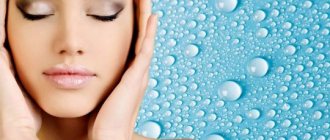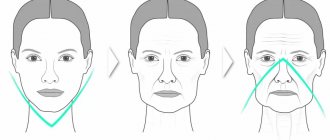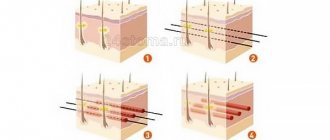In the struggle for youth and beauty, every year millions of people lie under the surgeon’s scalpel. However, such radical measures are not always necessary. In the arsenal of modern cosmetology, there are methods that can quickly eliminate or reduce age-related defects and restore the skin to a fresh, toned appearance. And all this without incisions, stitches and a long recovery period. One of these methods is thread correction APTOS (Aptos).
Non-surgical thread lifting or thread lifting (from the English thread - “thread”) is an intermediate procedure between therapeutic and surgical treatment. Like any invasive technique, thread correction requires a mandatory rehabilitation period.
How is the rehabilitation process going?
In order to avoid unnecessary worries, you need to know how rehabilitation proceeds, what unpleasant phenomena may occur, and what your face will look like immediately after installing APTOS threads.
Temporary hematomas can form both at the puncture site and in the regional (nearby) area. Usually hematomas go away on their own within a week. But with a tendency to bleeding and increased fragility of blood vessels, bruises persist for a longer time.
Transient edema. During thread correction, blood and lymphatic vessels are injured, which in turn causes tissue swelling. Swelling on the face after installing the threads appears immediately and lasts for several days, and then gradually subsides.
Pain. After the procedure, pain of varying severity may occur, which can be effectively relieved by taking painkillers. The face hurts after implantation of threads only in the first days. The discomfort goes away on its own within a week as the damaged tissues recover.
Lumpiness. In some cases, the installed threads do not immediately take the required position. This is especially true for spiral threads. In this regard, various defects may appear on the skin: tubercles, irregularities and folds. They often appear at the site of punctures. Within a week, the bumps on the face after installing the threads are completely smoothed out.
Violations of facial expressions and sensitivity. Minor disturbances in facial expressions are often associated with the effects of anesthesia, and disappear without a trace after the anesthetic wears off. But sometimes, as a result of intense tissue swelling, compression of the nerve branches occurs and, as a result, local numbness is observed. If the disturbances are persistent and do not go away within 3-4 days, you should consult a doctor.
Slight asymmetry of the face after implantation of threads may appear in the first hours and is caused by increasing swelling. This is a temporary phenomenon that resolves on its own after a few days.
Skin retractions at the puncture site are the result of tissue swelling and normally smooth out within 7-14 days. If defects persist, correction is required.
Contouring (thread protruding through the skin) is usually observed in the early postoperative period (first 3 days), when swelling develops and the thread prevents the tissue from straightening. If contouring persists longer, you should consult a doctor.
Get an online consultation
right now.
Get
The effect of hypercorrection is expressed in the form of overly prominent cheekbones and upturned eyebrows. You shouldn’t be afraid of this - in some cases the doctor consciously forms a hypercorrection, since the tissues tend to return to their original place.
It should be remembered that the above manifestations are not complications after installing threads on the face, but acceptable components of the postoperative period. The severity of negative phenomena is individual and depends on the characteristics of a particular organism. Even pronounced side effects disappear without a trace within three months and do not lead to functional impairment or visible cosmetic defects.
Indications and contraindications
In the recommendations and patient instructions, the manufacturer indicates several indications for use. The list looks like this:
- sagging skin;
- age-related changes in the soft tissues of the face;
- ptosis;
- the appearance of jowls (“bulldog cheeks”);
- formation of facial wrinkles;
- change in facial contour, development of a double chin;
- asymmetry.
Aptosis threads are not suitable for all patients. All contraindications are divided into absolute and relative.
The first group includes:
- severe tissue disorders that cannot be corrected;
- pregnancy;
- breastfeeding period;
- autoimmune disorders in the stage of decompensation;
- growth of malignant neoplasm, chemotherapy;
- inflammatory pathologies of ENT organs, oral cavity;
- infection with HIV, hepatitis viruses;
- previous implantations with non-absorbable materials;
- diabetes mellitus type 1 and 2 in the stage of decompensation;
- allergic reaction, risk of hypersensitivity;
- diseases associated with blood clotting disorders.
List of relative contraindications:
- hypertension above the second degree;
- coronary heart disease from functional class 2 and higher;
- use of antiplatelet agents (Aspirin), anticoagulants (Heparin);
- xerosis – excessive dry skin;
- moderate tissue atony;
- dermatoporosis – general thinning of the skin against the background of atrophic processes;
- hyperkinesis - involuntary muscle contraction;
- history of keloid scar formation.
Buyanov Sergey Yurievich (Expert Doctor):
Temporary contraindications also include the period of menstruation, during which the risk of interstitial bleeding is increased.
Recovery period
APTOS thread correction methods are constantly being improved, so the side effects and complications that were observed when installing first-generation threads are now virtually eliminated.
The duration of the recovery period varies depending on the anatomical features, individual anamnesis and the type of threads used.
The rehabilitation period after the installation of threads lasts from 2 days to a month, in some cases – up to 3 months. Patients under 50 years of age usually recover quickly and return to their normal lifestyle within a few days. On average, the stage of “psychological discomfort” lasts 7 days. The final aesthetic effect of the correction is fully manifested and consolidated in the post-procedure period: from 2 to 6 months after the lift.
At what age is it best to undergo thread lifting?
At what age APTOS threads can be installed is usually determined by a cosmetologist, since the condition of tissues in different patients at the same age may differ. But usually the recommendations are as follows:
- Up to 40 years – both absorbable and non-absorbable types of threads are used. The choice of material depends on their location and places of tightening.
- Up to 50 years - the introduction of only non-absorbable threads is indicated, which can be tightened by the surgeon over time.
- From 50 years and above - the introduction of non-absorbable threads is indicated, which are attached to the skin using incisions and suture material. The length of the incisions is up to 0.5 cm, and the incisions themselves are localized in inconspicuous places (scalp, behind the ears).
What not to do after installing threads
The main rule for successful and quick rehabilitation is careful treatment of the correction zone. Until the threads are securely fixed in the skin, any physical impact can lead to unpredictable consequences. The final result of the procedure largely depends on how the rehabilitation goes after installing threads on the face. Therefore, in the early recovery period it is extremely important to observe the following restrictions:
- In the first 2-3 days, do not consume hot food and drinks. You should also avoid solid, rough foods to avoid stress on the masticatory muscles.
- For 10 days, general thermal procedures are excluded: bathhouse, solarium, sauna, hot shower and bath. Heat exposure to correction areas is prohibited for a month.
- It is necessary to avoid active facial movements for at least 10-14 days.
- Do not massage the skin where the threads are installed. Deep massage is excluded for up to 2-3 months.
- You should not engage in sports or physical labor for 2-3 weeks.
- You should stop drinking alcohol for 10-14 days.
- You must not sunbathe for one month. Before going outside, you must apply products with a high sun protection factor.
Prices
| Service | Time | Price |
TREADLIFTING - CORRECTION OF FACIAL OVAL WITH THREADS WITH NOTCHES | ||
| Aptos Nano Visage (10 threads -70 mm) | 60 min | 22900rub |
| Aptos Visage Soft (10 threads - 190 mm) | 60 min | 29900rub |
| Aptos Excellence Visage (10 threads - 190 mm) | 60 min | 38900rub |
| Aptos Excellence Body (10 threads - 240 mm) | 60 min | 28800rub |
| Aptos Thread 2G | 60 min | 38900rub |
Anesthesia | ||
| Cream "Akriol Pro" | 30 min | 500r |
| Artikain | 5 minutes | 500r |
Make an appointment
by phone +7 (985) 228-44-55
via whatsapp
Rehabilitation procedures after thread lift
In the first 48 hours, cold must be applied to the correction area. For this purpose, it is convenient to use special pharmacy cryopacks. Cold will reduce swelling and relieve pain. For 10-14 days, it is better to sleep on your back and on a high pillow to prevent the threads from moving and worsening swelling. If this is difficult, you should apply an elastic bandage while you sleep.
In case of severe pain, you should take painkillers: Nurofen, Nise. Sometimes headaches occur after installing facial threads. This symptom is effectively eliminated with analgesics and antispasmodics: Spazgan, Baralgin.
To speed up the resolution of hematomas, it is recommended to use angioprotectors and venotonics: Traumeel, Troxerutin, Lyoton 1000. The products are applied along certain lines to prevent deformation of the threads.
To prevent the development of infectious complications, puncture sites are treated with antiseptic solutions for 3 days: “Chlorhexidine”, “Miramistin”.
In cases of extensive surgery and an increased risk of infectious and inflammatory complications, the use of broad-spectrum antibacterial drugs is indicated. The need for antibiotics is determined by the attending physician.
To eliminate nervous tension and normalize sleep, herbal sedatives are recommended. And after the procedure, it is advisable to use special cosmetics intended for skin after invasive procedures. You need to sleep in a compression mask.
Advantages and disadvantages
Like any cosmetic procedure, a facelift with Aptos threads has both positive and negative sides. Details in the table.
| pros | Minuses |
|
|
Cosmetic procedures after thread correction
To shorten the rehabilitation period and enhance the effect of the intervention, the attending physician may recommend various cosmetic and physiotherapeutic procedures.
Microcurrents, ultrasound, phonophoresis have a pronounced lymphatic drainage effect, effectively neutralize inflammatory reactions and stimulate the immune system. Under the influence of physical procedures, the synthesis of collagen and elastin increases, which enhances the effectiveness of thread correction methods.
Local cryotherapy is the use of low temperature (up to –20°C) for therapeutic purposes. As a result of cold exposure, a short-term analgesic effect develops, the resorption of hematomas is accelerated, tissue regeneration is activated, and muscle tension is eliminated.
Aerocryotherapy is short-term exposure to ultra-low temperatures (down to – 170°C). By reducing the conductivity of nervous tissue, a long-lasting analgesic effect is achieved (up to 8 hours). The method has a pronounced anti-inflammatory effect and serves as a prevention of infectious complications.
Comparison with analogues
Aptos threads were created in Russia, the authors of the methods are domestic surgeons.
The quality of the material meets all requirements and standards and is in no way inferior to foreign analogues. The product is respected and appreciated for its diversity and the ability to select an individual approach to the patient.
Cosmetologists also use:
- French Spring Thread, Resorblift;
- Italian Happy lift;
- Spanish Silhouette Lift, Silhouette Soft;
- South Korean Kogi mesothreads;
- Japanese analogues.
It is impossible to say with 100% certainty which material is better. Products differ in composition, capabilities, indications for use and other nuances. The selection of threads is carried out exclusively by a cosmetologist.
Opinion of cosmetologists
On forums, experts share their opinions about this procedure. Here are some reviews about Aptos threads regarding effectiveness and rules of use:











